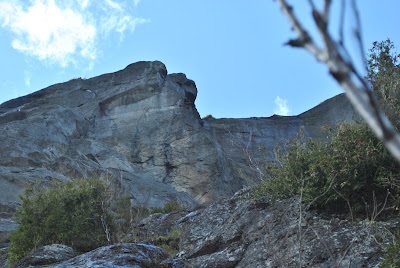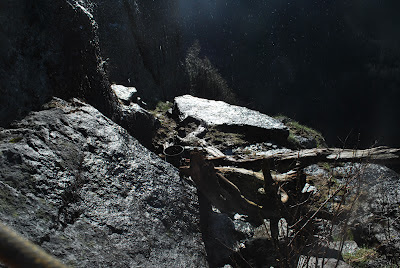Joe, Cam, and I decided to head to the High Peaks region of the Adirondacks for our last climbing trip of the semester. The goal was to climb
"The Diagonal" on Wallface, an 860ft climb. We left Troy after exams on Friday at 12:20 pm, arriving at the parking lot around 2 hours later. There is a normal hiking trail that leads to a climber "trail" which follows small cairns to the base of the cliff. Most of the trails were wet, swampy, and rocky, but we hoped that the route would end up being dry. The boulders around the cairns that mark out the climber's trail were huge, and I was surprised not to see any chalk marks or areas cleared out for bouldering pads. Hiking from the parking lot to the first "real" stream crossing took right around an hour, and from there it was another hour and a half to the cliffs.



The 4 mile long approach was all worth it when we reached the base of the cliff, the tallest in New York State. Some people call this the El Cap of the East even thought it is only 1/10 the size. From the base of the cliff, we could tell that the first two pitches, both 5.5G, were going to be wet and dirty, so we opted out of putting on our rock climbing shoes. Cam took the lead on both of these pitches, the second being the most difficult. We were all carrying gear to spend the night on the wall, so climbing with heavy packs added to the difficulty of the route. Up near the top of P2, Cam took off his pack while on lead and anchored it with a hex in a crack. I followed with my pack, pulling pro, and rappelled off of the other end of the rope to find Cam's pack while Joe climbed up. With the pack on my back, I prusiked back up the rope and prepared to lead the next pitch.

Pitch 3 heads directly up the ramp, one of the most defined features on The Diagonal. This is a 5.3 PG13 slab, and it ended up being soaking wet in areas. I started up the slab, placing a cam for my first piece of protection. This is where the PG13 part comes in. I followed a slanting crack to the right side of the ramp, where it was the most dry, and ended up much further above my protection than I would have liked to be. With my nerves starting to kick in, I climbed even more right to a potential spot for protection, in which I places a medium sized nut. This placement wasn't the best, so I backed it up with a ballnut about a foot down the crack. My only option now was to down climb and try to head up on the left side of the ramp where it was more dry. I left the protection in, even though it caused horrible rope drag, and found an easier route further along the ramp. Gear was all good from there on, and I made it to the top of the belay anchors at the top of the ramp.
Cam followed up the ramp, still needing to head far right to remove the nut and ballnut. Cam decided to pendulum to the left instead of traversing in an attempt to save time. In the process of swinging, the link cam that I had placed towards the top of the ramp blew out and sped down the rope to Cam. The jolt was totally unexpected, but the belay anchors held strong and nobody got hurt, so all was good.
 |
| At the top of the ramp |
All up at the top of the ramp, Cam took the lead again and headed up P4. The goal for the climbing today was to reach the ledge on the top of P4, so we were on track to get there just as it was getting dark. For some reason there was not enough rope length for Cam to make it to the ledge, so after belaying me up to where he was, I took the lead and finished off the pitch. Even though I had a full rack of gear, all I needed were quickdraws because there were two bolts on the first face, and then two more at the top.
 |
| Cam on the bottom part of P4 |
Once we were all up on the ledge, it was time to make it a little more habitable for the night. Joe moved loose rocks and two large tree branches off to the side where we were not going to be sleeping. Cam and I set up an anchor/gear storage system so we could all stay clipped in to our harnesses at all times. The blue sling on the left was used for gear storage and organization. The other sling was set up like a dog leash system. I clipped in to the sling with my PAS and then Cam clipped in to my chain so he would have more room to move around. Joe remained anchored in with a clove hitch. After heating up some tuna glop and a freeze dried meal we cleaned up the kitchen area and set out the sleeping pads. The ledge was not smooth by and means, but it was better than hanging in a harness all night.
 |
| Anchor setup for sleeping and storage |
Cam demonstrates the "I can't believe I left my rock climbing shoes at home" face. On the other hand, I was totally fine with my shoes and couldn't be happier on the ledge. There was a lot of water falling from the roof above down to the side of where we set up sleeping bags, so we set up water bottles and my cooking pot underneath the heavy drips, which yielded about one liter of water every hour.
 |
| All set up at night... |
 |
| Water collection system |
P5 was a 4th class traverse that led to the next three pitches of solid 5.8 climbing. I tied in for the lead on P6, but could not figure out how to make the next move after placing two pieces of protection, so Cam lowered me off of a 0.75 cam and a ballnut before finishing off the pitch.
 |
| Attempting the lead on P6 |
 |
| Cam belaying for P6... |
 |
| ...and then finishing off the lead |
 |
| View from the top of P6 |
I wanted to lead the next pitch, so Cam and I transferred gear and I headed up the distinct crack in the photo below. I placed a #10 and #11 hex in the crack. and then clipped an old piton above the first major ledge in the photo. A small slab section followed this crack, but I realized that I didn't have enough slings or quickdraws to protect anything past the slab, so I built an anchor with a #2 cam and an old piton to belay Cam up. We swapped gear once again and he continued climbing to the top. Finally, we belayed Joe up the last two pitches and then got ready to rappel.
 |
| P7 Crack |
 |
| Belay anchor at the top of P7 |
 |
Looking up P8, getting ready to follow.
There were 5 old pitons on this pitch, but they didn't look reliable enough to clip. |
 |
| Top anchor on P8, the end of the climb. |
 |
| Setting up for a 60m rappel |
After four full 60m rappels, we all arrived back at the base of the cliff. We made our way back to main trail by following the cairns marking the climber's path, and then hiked another 2 hours back to the parking lot where we started off.
 |
| Still some snow on the ground |
 |
| Wallface Panorama |
 |
| Descending the ladders |
















